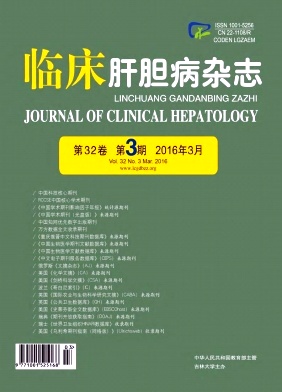|
[1]FAN JG.Epidemiology of alcoholic and nonalcoholic fatty liver disease in China[J].J Gastroenterol Hepatol,2013,28(Suppl 1):11-17.
|
|
[2]FESTI D,SCHIUMERINI R,MARZI L,et al.Review article:the diagnosis of non-alcoholic fatty liver disease-availability and accuracy of non-invasive methods[J].Aliment Pharmacol Ther,2013,37(4):392-400.
|
|
[3]ANSTEE QM,TARGHER G,DAY CP.Progression of NAFLD to diabetes mellitus,cardiovascular disease or cirrhosis[J].Nat Rev Gastroenterol Hepatol,2013,10(6):330-344.
|
|
[4]European Association for the study of the Liver.EASL clinical practical guidelines:management of alcoholic liver disease[J].J Hepatol,2012,57(2):399-420.
|
|
[5]Expert Committee on the Diagnosis and Management of Fatty Liver Disease,Chinese Medical Association.Recommendation for the standardization of diagnosis and treatment of fatty liver disease[J].J Clin Hepatol,2013,29(9):652-655.(in Chinese)中国医师协会脂肪性肝病专家委员会.脂肪性肝病诊疗规范化的专家建议[J].临床肝胆病杂志,2013,29(9):652-655.
|
|
[6]NASCIMBENI F,PAIS R,BELLENTANI S,et al.From NAFLD in clinical practice to answers from guidelines[J].J Hepatol,2013,59(4):859-871.
|
|
[7]CASTERRA L,VILGRAIN V,ANGULO P.Noinvasive evaluation of NAFLD[J].Nat Rev Gastroenterol Hepatol,2013,10(11):666-675.
|
|
[8]KHOV N,SHARMA A,RILEY TR.Bedside ultrasound in the diagnosis of nonalcoholic fatty liver disease[J].World J Gastroenterol,2014,20(22):6821-6825.
|
|
[9]MYERS RP,POLLETT A,KIRSCH R,et al.Controlled attenuation parameter(CAP):a noninvasive method for the detection of hepatic steatosis based on transient elastography[J].Liver Int,2012,32(6):902-910.
|
|
[10]CHAN WK,NIK MUSTAPHA NR,MAHADEVA S.Controlled attenuation parameter for the detection and quantification of hepatic steatosis in non-alcoholic fatty liver disease[J].J Gastroenterol Hepatol,2014,29(7):1470-1476.
|
|
[11]CHON YE,JUNG KS,KIM SU,et al.Controlled attenuation parameter(CAP)for detection of hepatic steatosis in patients with chronic liver diseases:a prospective study of a native Korean population[J].Liver Int,2014,34(1):102-109.
|
|
[12] SASSO M,TENGHER-BARNA I,ZIOL M,et al.Novel controlled attenuation parameter for noninvasive assessment of steatosis using Fibroscan:validation in chronic hepatitis C[J].J Viral Hepat,2012,19(4):244-253.
|
|
[13]SCAGLIONI F,CICCIA S,MARION M,et al.ASH and NASH[J].Dig Dis,2011,29(2):202-210.
|
|
[14] VERNON G,BARANOVA A,YOUNOSIS ZM.Systematic review:the epidemiology and natural history of non-alcoholic fatty liver disease and non-alcoholic steatohepatitis in adults[J].Aliment Pharmacol Ther,2011,34(3):274-285.
|
|
[15]WANG FS,FAN JG,ZHANG Z,et al.The global burden of liver disease:the major impact of China[J].Hepatology,2014,60(6):2099-2108.
|
|
[16]HU X,HUANG Y,BAO Z,et al.Prevalence and factors associated with nonalcoholic fatty liver disease in Shanghai work-units[J].BMC Gastroenterol,2012,12(35):123.
|
|
[17]CARVALHANA S,LEITO J,ALVES AC,et al.How good is controlled attenuation parameter and fatty liver index for assessing liver steatosis in general population:correlation with ultrasound[J].Liver Int,2014,34(6):e111-e117.
|
|
[18]FERRAIOLI G,TINELLI C,LISSANDRIN R,et al.Controlled attenuation parameter for evaluating liver steatosis in chronic viral hepatitis[J].World J Gastroenterol,2014,20(21):6626-6631.
|
|
[19]KUMAR M,RASTOGI A,SINGH T,et al.Controlled attenuation parameter for non-invasive assessment of hepatic steatosis:does etiology affect performance?[J].J Gastroenterol Hepatol,2013,28(7):1194-1201.
|
|
[20]SCHWEZER NF,SPRINGER F,SCHRAML C,et al.Noninvasive assessment and quantification of liver steatosis by ultrasound,computed tomography and magnetic resonance[J].J Hepatol,2009,51(3):433-445.
|
|
[21]MEHTA SR,THOMAS EL,BELL JD,et al.Noninvasive means of measuring hepatic fat content[J].World J Gastroenterol,2008,13(22):3476-3483.
|
|
[22]ZEB I,LI D,NASIR KG,et al.Computed tomography scans in the evaluation of fatty liver disease in a population based study:the multi-ethnic study of atherosclerosis[J].Acad Radiol,2012,19(7):811-818.
|
|
[23] MYERS RP,POLLETT A,KIRSCH R,et al.Controlled attenuation parameter(CAP):a noninvasive method for the detection of hepatic steatosis based on transient elastography[J].Liver Int,2012,32(6):902-910.
|
|
[24]SHEN Y,ZHANG J,CAI H,et al.Identifying patients with chronic hepatitis B at high risk of type 2 diabetes mellitus:a cross-sectional study with pair-matched controls[J].BMC Gastroenterology,2015,15(1):32.
|
|
[25]PARK SK,SEO MH,SHIN HC,et al.Clinical availability of nonalcoholic fatty liver disease as an early predictor of type 2 diabetes mellitus in Korean men:5-year prospective cohort study[J].Hepatology,2013,57(4):1378-1383.
|
|
[26]de LEDINGHEN V,VERGNIOL J,FOUCHER J,et al.Non-invasive diagnosis of liver steatosis using controlled attenuation parameter(CAP)and transient elastography[J].Liver Int,2012,32(6):911-918.
|









 本站查看
本站查看




 DownLoad:
DownLoad: